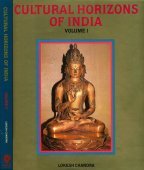Shailendra, Śailendra, Shaila-indra, Shailemdra: 9 definitions
Introduction:
Shailendra means something in Hinduism, Sanskrit, the history of ancient India, Hindi. If you want to know the exact meaning, history, etymology or English translation of this term then check out the descriptions on this page. Add your comment or reference to a book if you want to contribute to this summary article.
The Sanskrit term Śailendra can be transliterated into English as Sailendra or Shailendra, using the IAST transliteration scheme (?).
In Hinduism
Shaktism (Shakta philosophy)
Source: Google Books: ManthanabhairavatantramŚailendra (शैलेन्द्र) refers to the “Himalaya”, according to verse 11.36-38 of the Kularatnoddyota, one of the earliest Kubjikā Tantras.—Accordingly, “When the (goddess) born in the family of the Himalaya (tuhina-śailendra) will assume a body, Skanda (Ṣaṇmukha) will be her son. Then Mitreśa who is accompanied by his consort, will tell his consort the teaching of knowledge in a solitary place (but) will not tell (it) to (his) son. O fair lady, out of anger, his son Skanda will throw that book into the sea and a fish will swallow it”.

Shakta (शाक्त, śākta) or Shaktism (śāktism) represents a tradition of Hinduism where the Goddess (Devi) is revered and worshipped. Shakta literature includes a range of scriptures, including various Agamas and Tantras, although its roots may be traced back to the Vedas.
Purana and Itihasa (epic history)
Source: archive.org: Shiva Purana - English TranslationŚailendra (शैलेन्द्र) refers to the “lord of the mountains” and is used to describe Himavat (Himācala), according to the Śivapurāṇa 2.3.33 (“The appeasement of Himavat”).—Accordingly, the Seven Sages said to Himavat (Himācala): “O lord of the mountains (śailendra), may our words, the cause of everything auspicious, be heard. Give Pārvatī to Śiva. Become the father-in-law of the world-destroyer. For the destruction of Tāraka, formerly Brahmā requested Śiva who is the lord of all and who does not beg of any one, to strive for this alliance. [...]”.

The Purana (पुराण, purāṇas) refers to Sanskrit literature preserving ancient India’s vast cultural history, including historical legends, religious ceremonies, various arts and sciences. The eighteen mahapuranas total over 400,000 shlokas (metrical couplets) and date to at least several centuries BCE.
India history and geography
Source: archive.org: Geography in Ancient Indian inscriptionsŚailendra (शैलेन्द्र) is another name for the varṣaparvata (mountain range) named Himavat.—The Himavat range is said to have stretched along, on the north of Bhārata, like the string of a bow.

The history of India traces the identification of countries, villages, towns and other regions of India, as well as mythology, zoology, royal dynasties, rulers, tribes, local festivities and traditions and regional languages. Ancient India enjoyed religious freedom and encourages the path of Dharma, a concept common to Buddhism, Hinduism, and Jainism.
Languages of India and abroad
Sanskrit dictionary
Source: DDSA: The practical Sanskrit-English dictionaryŚailendra (शैलेन्द्र).—epithets of the Himālaya.
Derivable forms: śailendraḥ (शैलेन्द्रः).
Śailendra is a Sanskrit compound consisting of the terms śaila and indra (इन्द्र). See also (synonyms): śailādhipa, śailādhirāja, śailapati, śailarāja.
Source: Cologne Digital Sanskrit Dictionaries: Cappeller Sanskrit-English DictionaryŚailendra (शैलेन्द्र).—[masculine] = śailarāj.
Source: Cologne Digital Sanskrit Dictionaries: Monier-Williams Sanskrit-English DictionaryŚailendra (शैलेन्द्र):—[from śaila] m. the chief or lord of m° ([especially] as Name of the Himālaya), [Rāmāyaṇa; Mārkaṇḍeya-purāṇa]
[Sanskrit to German]
Sanskrit, also spelled संस्कृतम् (saṃskṛtam), is an ancient language of India commonly seen as the grandmother of the Indo-European language family (even English!). Closely allied with Prakrit and Pali, Sanskrit is more exhaustive in both grammar and terms and has the most extensive collection of literature in the world, greatly surpassing its sister-languages Greek and Latin.
Hindi dictionary
Source: DDSA: A practical Hindi-English dictionaryShailendra in Hindi refers in English to:—(nm) the Himalayas..—shailendra (शैलेंद्र) is alternatively transliterated as Śaileṃdra.
...
Kannada-English dictionary
Source: Alar: Kannada-English corpusŚailēṃdra (ಶೈಲೇಂದ್ರ):—[noun] = ಶೈಲಪ [shailapa].
Kannada is a Dravidian language (as opposed to the Indo-European language family) mainly spoken in the southwestern region of India.
See also (Relevant definitions)
Partial matches: Shaila, Indra.
Starts with: Shailendraduhitri, Shailendraja, Shailendrakanya, Shailendranagara, Shailendraraja, Shailendrarajasamghattanaghosha, Shailendrashrigarbharaja, Shailendrastha, Shailendrasuta, Shailendravamsha.
Ends with: Shleshmashailendra, Varanashailendra.
Full-text: Gaudidvipa, Shailendraduhitri, Shailemdra, Shailendrasuta, Shailendrastha, Shailendraja, Kumaraghosha, Shailadhipa, Shailadhiraja, Shailaraja, Shailapati, Balaputradeva, Shleshmashailendra, Butea frondosa, Palasha, Himavat, Vri, Mahendra, Stha, Divine chariot.
Relevant text
Search found 18 books and stories containing Shailendra, Śailendra, Sailendra, Shaila-indra, Śaila-indra, Saila-indra, Shailemdra, Śailēṃdra, Śailēndra; (plurals include: Shailendras, Śailendras, Sailendras, indras, Shailemdras, Śailēṃdras, Śailēndras). You can also click to the full overview containing English textual excerpts. Below are direct links for the most relevant articles:
Sahitya-kaumudi by Baladeva Vidyabhushana (by Gaurapada Dāsa)
Text 10.204 < [Chapter 10 - Ornaments of Meaning]
Text 10.180 < [Chapter 10 - Ornaments of Meaning]
Middle Chola Temples (by S. R. Balasubrahmanyam)
Temples in Nagapattinam < [Chapter II - Temples of Rajaraja I’s Time]
The Golden Age of Hindu-Javanese Art < [September-October 1932]
Indian Culture in Cambodia < [January 1957]
Indian Culture in South-East Asian Countries < [July – September 1973]
Amaravati Art in the Context of Andhra Archaeology (by Sreyashi Ray chowdhuri)
Coastal and Maritime trade < [Chapter 4 - Survival of Amarāvatī in the Context of Andhra Art]
Vietnamese Buddhist Art (by Nguyen Ngoc Vinh)
3. History of South East Asia < [Chapter 2 - Similarity of Buddhist monuments in South Vietnam and South East Asia]
2a. The Spread of Buddhism < [Chapter 1 - The evolution of Buddhist Art in South Vietnam and South East Asia]
7. Buddhist monuments in Indonesia and Borobudur < [Chapter 2 - Similarity of Buddhist monuments in South Vietnam and South East Asia]
Vastu-shastra (5): Temple Architecture (by D. N. Shukla)
Temple architecture in Java and Bali < [Chapter 12 - History of Hindu Temples (Prāsādas and Vimānas)]
Temple architecture in Prambanam [Prambanan] < [Chapter 12 - History of Hindu Temples (Prāsādas and Vimānas)]
Related products
